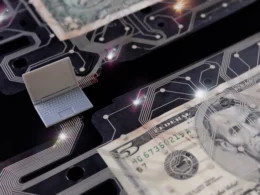Cryptocurrencies are taking over the entire world as they continue to gain mainstream adoption. But how does crypto come into existence? It is through two ways, mining and staking, which are the most common methods for validating transactions and securing the blockchain.
We get it. You must have several questions here. What’s the difference between crypto mining and crypto staking? What is it that separates them? Which one is better? So, without further ado, let’s dive into crypto mining VS staking!
What is Crypto?

Crypto assets have emerged as one of the most exciting and lucrative forms of investment over the last few years. It is a digital or virtual currency that uses cryptography to secure transactions, making it nearly impossible to counterfeit or double-spend. Crypto is a peer-to-peer system that runs on a distributed public ledger called the blockchain.
Blockchain is a decentralised technology, meaning there is no central authority in control rather than distributed across different nodes (computers) worldwide.
The node operators validate the transactions and store them in the public ledger. All the nodes in the decentralised network arrive at the correct answer using a “consensus mechanism.” This consensus can be achieved by two methods: mining or staking.
The basic difference between the two is the algorithm used to validate transactions and add new blocks to the blockchain.
What is Crypto Mining?

Crypto mining comes from the ‘Proof of Work’ (PoW) mechanism, where the network utilises a huge amount of processing power to solve a complex problem to achieve consensus to validate transactions between strangers and ensure the same money is not spent twice. This process also helps secure the network and prevents bad actors from hijacking the network.
To perform complex calculations, miners need powerful GPUs (Graphics Processing Units), which are expensive and hard to maintain. Every time they use their hash power to successfully mine a block, they get awarded a set amount of cryptocurrency they are mining.
The computing power is called the hash rate, which determines the difficulty of processing transactions in the blockchain. This is the basic mantra here: if more miners are mining with increasingly powerful hardware, the hashrate goes up, and so does the degree of difficulty for mining. And if miners leave the network due to market conditions or unprofitability, the hashrate goes down. This leads to an increase in the degree of difficulty in mining cryptocurrency.
Bitcoin is the most popular example of PoW, where miners compete to be the first to solve a cryptographic puzzle and win the right to add the latest block of verified transactions on the blockchain, in return for which they receive BTC rewards. There will only ever be 21 million Bitcoin, with about 19.2 million BTC currently circulating in the market. Interestingly, the last 21 millionth BTC won’t be mined until 2140.
Currently, Ethereum also uses the PoW consensus algorithm, but it is currently undergoing the transition to Proof of Stake (PoS) due to the bottlenecks caused by PoW. With a huge variety of applications, including the entire ecosystems of DeFi, NFT, and GameFi running on the Ethereum blockchain, it needs scalability, high speed, and low fees.
What is Crypto Staking?

An alternative to Proof-of-Work (PoW) mechanism, crypto staking has the same objectives as mining in terms of validating transactions and achieving consensus. But instead of mining the coins, in this method, crypto holders’ stake’ their coins.
In Proof-of-Stake (PoS), there is no need for expensive and energy-intensive GPUs. Instead, users lock their coins in for a fixed period, as they cannot withdraw their crypto assets during this time.
Depending on a node’s size and time of staking, the network chooses a validator for each block. In exchange for locking their tokens, miners receive staking rewards that depend on how long the cryptos are locked.
Staking is buying crypto with the intention of locking it for an indefinite period, and the longer you hold them, the higher the interest you receive. The staking process only lasts as long as you keep the coins locked. Meanwhile, the rate of interest or reward varies from network to network and is usually paid out in the form of the coin itself.
In the PoS model, validators (miners) need to only have an internet connection and the relevant cryptocurrency to stake. As such, unlike PoW, you don’t need advanced skills or extensive energy to solve cryptographic puzzles to find a new block.
Staking services are also offered by crypto exchanges like Coinbase and Binance, where users lock their crypto in pools, making them illiquid, and earn interest on it for the prescribed duration.
Ethereum is currently making a shift to the PoS mechanism, which will make the network more scalable and sustainable. Other examples of PoS include Binance Coin (BNB), Solana (SOL), Polkadot (DOT), Tezos (XTZ), Cosmos (ATOM), and Cardano (ADA).
Pros of Crypto Mining VS Staking

When it comes to crypto mining, you get to earn rewards for dedicating your resources to validate transactions and secure the network. For instance, when Bitcoin was created in 2008, the reward for confirming a block of transactions was 50 Bitcoins. But after going through three halvings, it has now come down to 6.25 BTC.
While the cost of mining has increased significantly now that a large number of the population knows about Bitcoin and crypto, mining is still profitable, especially for those with a powerful mining setup.
Crypto mining further offers the benefit of lower fees, immediate settlement, inability to counterfeit, and is accessible to everyone. Unlike traditional banks that can freeze your assets, you have complete control over your crypto here. It also puts an end to identity theft as you’ll never have to worry about someone stealing the RFID information in your debit or credit card at the checkout.
When it comes to crypto staking, it has much lower barriers to entry with simpler ways to participate via exchanges like Coinbase. This means that investors can contribute an amount they can afford to a staking pool and earn rewards without operating their own validator hardware.
Staking makes it easier for holders to earn returns on their assets. It is also an excellent way for long-term crypto holders to put their crypto to work and earn rewards. Additionally, staking means contributing to the security and efficiency of the blockchain projects you support.
Cons of Crypto Mining VS Staking

While profitable, crypto mining may cost a fortune. Not only do you have to invest in expensive mining rigs, but you also have to bear the cost of hefty electricity bills. Moreover, unlike in 2008, when you could mine Bitcoin on your computer and earn big rewards, it isn’t possible anymore.
So, in the beginning, mining is easy and fast, but in the long run, as more participants join, it becomes harder to keep mining with fewer puzzles to be solved. It is, after all, the first person who is the first to mine a block that receives the reward.
Investing in mining rigs isn’t a one-time thing either. For the best chances of being selected to mine the next block, you need GPUs at their maximum potential to keep the mining software up and running, which translates to a decreased lifespan of your graphic cards.
Additionally, the crypto market is inherently volatile, which makes it a risky venture for not just investors but also miners. For instance, the stocks of Bitcoin miner Marathon Digital (MARA) lost about 93% of their value between Nov. 2021 and June 2022.
Meanwhile, the disadvantage of going with staking is that you have a vesting period during which you won’t be able to use them. This means missing out on potential opportunities, especially during periods of volatility. So, make sure, before staking, you research the specific staking requirements and rules for each project.
The most significant risk comes when the price goes down, which you need to keep in mind, especially for those projects that offer incredibly high staking reward rates. For instance, many smaller crypto projects offer attractive high rates to lure investors, but their prices then end up crashing. And in crypto, they can easily go down more than 90%.
Even when you want to unstake your crypto, there may be an unstaking period involved, such as a week or month.
While open to anyone who wants to participate, becoming a full validator requires technical knowledge, a dedicated computer to perform validations, and a substantial minimum investment. For instance, to become a validator on ETH2.0, one must have 32 ETH.
Conclusion

No matter the method used to achieve consensus, both mining and staking have their own pros and cons, as discussed above. The decision to go with staking or mining is yours, and you can invest in any of the ways.
But given the plethora of variables involved in cryptocurrencies using Proof-of-Work and Proof-of-Stake, claiming one is more profitable than the other is quite tricky. After all, both methods reward users with the network’s native crypto, which depends on each project and its tokenomics.









